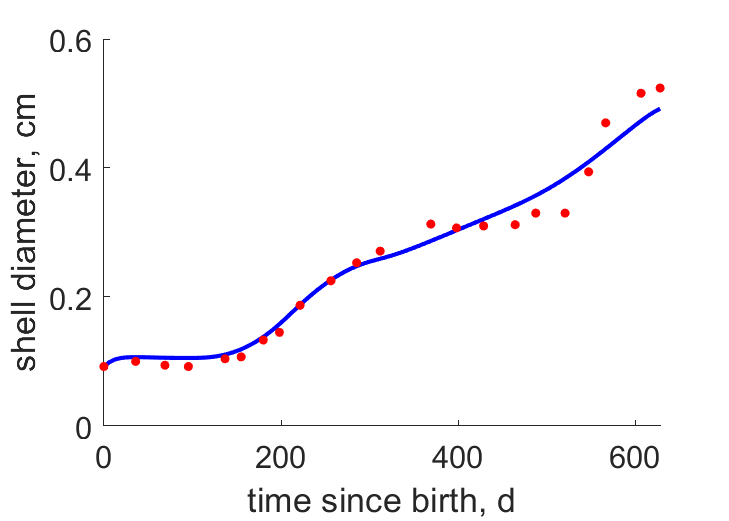Predictions & Data for this entry
| Model: std | climate: ME | migrate: | phylum: |
| COMPLETE = 2.5 | ecozone: MS | food: biHa | class: |
| MRE = 0.009 | habitat: 0iMb | gender: D | order: |
| SMSE = 0.001 | embryo: Ms | reprod: O | family: |
Zero-variate data
| Data | Observed | Predicted | (RE) | Unit | Description | Reference |
|---|---|---|---|---|---|---|
| am | 1460 | 1460 | (0.000114) | d | life span | Pick1979 |
| Lb | 0.094 | 0.09163 | (0.02521) | cm | shell diameter at birth | Pick1979 |
| Lp | 0.3 | 0.3 | (0.0001165) | cm | shell height at puberty for female | guess |
| Li | 0.71 | 0.7126 | (0.003626) | cm | ultimate shell height | Pick1979 |
| Wdi | 0.00167 | 0.001666 | (0.002479) | g | egg dry weight | Pick1979 |
| Ri | 0.1288 | 0.1279 | (0.00635) | #/d | maximum reprod rate | Pick1979 |
Uni- and bivariate data
| Data | Figure | Independent variable | Dependent variable | (RE) | Reference |
|---|---|---|---|---|---|
| tL |  | time since birth | shell diameter | (0.06575) | Pick1979 |
Pseudo-data at Tref = 20°C
| Data | Generalised animal | Laevilacunaria antarctica | Unit | Description |
|---|---|---|---|---|
| v | 0.02 | 0.0205 | cm/d | energy conductance |
| kap | 0.8 | 0.9577 | - | allocation fraction to soma |
| kap_R | 0.95 | 0.95 | - | reproduction efficiency |
| p_M | 18 | 446.5 | J/d.cm^3 | vol-spec som maint |
| k_J | 0.002 | 0.002 | 1/d | maturity maint rate coefficient |
| kap_G | 0.8 | 0.8007 | - | growth efficiency |
Discussion
- Males are assumed not to differ from females
- Temperature (in C) for tL data is assumed to vary in time (in d) as T(t)=3+3*sin(2*pi*(t-160)/365)
- Scaled functional respose for tL data is assumed to vary in time
Facts
- No larval stages (Ref: Pick1979)
- length-weight: log10(dry weight in g) = 3.1050*log10(shell diameter in mm) - 4.4207 (Ref: Pick1979)
Acknowledgment
- The creation of this entry was supported by the Norwegian Science Council (NFR 255295)
Bibliography